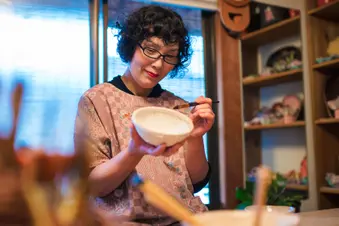
You can live a full life with geographic atrophy (GA). With a few adjustments, you can still take part in many of your favorite hobbies. You might also discover some new ones.
How to Enjoy Your Favorite Activities
You can adapt many of your favorite activities to fit your vision needs.
Reading. You can still enjoy books, magazines, and newspapers by using large-print or audio versions of reading materials. Check your local library for large-print books. The National Library Service for the Blind and Print Disabled is a free service for eligible people with low vision. You can access a national network of libraries to download books and magazines in Braille or audio formats, or have them delivered to your home.
Games. Love a good game of checkers or gin rummy? Many popular games come in adapted versions for people with low vision. You can find large-print, large format, and Braille versions of playing cards, chess, and Monopoly. Look for games like dominoes and dice with raised numbers or bumps. Try large-print versions of cards, crossword puzzles, and Scrabble.
TV, movies, and theater. Many movies, television shows, and theater productions come with an audio description option that tells you what’s happening in each scene. You may find audio-described operas, concerts, and political events. Ask your theater if they have headsets with audio-described performances. Some theaters offer special preview sessions before a performance begins, so staff can share details about the plot. You can also try magnifiers, telescopes, and binoculars to see the production better.
Exercise. Being active helps you stay healthy, lowers stress, and improves concentration. Bicycles, rowing machines, and treadmills make it easy to safely exercise at home. You can also try gentle activities such as swimming, tai chi, and walking.
Cooking. Simple changes can make your kitchen better suited to your needs. Use large-print recipes or a handheld magnifier to read recipes and labels. Get dark- and light-colored cutting boards and use brightly colored labels on temperature controls so it’s easier to see what you’re doing. Make measurements easier to read by using special tactile labels (these labels use raised shapes or textures so you can identify objects by touch) or a talking scale.
Gardening. Organize your garden so it’s easy to see plants and weeds. Plant everything in straight lines. Use brightly colored labels so you can keep track of your plants. Use light, handheld garden tools and keep them in an apron or a utility belt with easy-to-reach pockets. Make it simple to water your plants and vegetables with underground tubing. For less maintenance, try a smaller garden or plant flowers in pots.
Sewing. Simple tips and tricks can make sewing easier. A tactile tape measure displays measurements by touch. You can use a magnet to pick up needles and pins that fall on the floor. Use different color threads for color contrast. If you’re sewing a dark button onto something dark, place white tissue paper between the fabric and the button so it’s easier to see. Use a magnetic seam guide with your sewing machine. Try putting masking tape on the feeder to guide you.
Find New Hobbies
You have many choices for hobbies that are safe and easy to enjoy with GA.
Listen to a podcast. Whether you’re interested in arts, culture, history, science, or something else, you can find a podcast about it. Browse through options on your phone or computer on podcast apps, such as Apple Podcasts and Spotify.
Go on an audio tour. Visit a local museum or zoo and pick up a pair of audio tour headphones. As you walk around, you can hear highlights and background information about the animals or exhibits.
Dive into the arts. Try an art class or tour an art gallery or a museum. Learn about sculpture, painting, or photography. Ask if they offer audio tours or have verbal descriptions for people with low vision. Or use a smartphone app that offers video descriptions.
Enjoy music. Give your eyes a rest and listen to music. Learn how to play an instrument. Try playing by ear or use an assistive device like screen-magnifying equipment or a Braille version of written music.
Dance. Pair music with dance. Try something new, like ballroom dancing or salsa. Do it by yourself, or connect with others in a dance class or group.
Be social. Spend time with friends and family. Join a group or volunteer with an organization you care about to make new friends and connections while finding new things to enjoy.
Try new games. If you love fun and competition, try a new game. Download a game on your smartphone made for users with low vision, such as Blind Cricket, Blindfold Solitaire, or Blindfold Word Games. You may also want to try games that aren’t intended for users with low vision, like Bomb Disarmer, Super Simon, Bejeweled, or slot machines.
Show Sources
Photo Credit: JGalione / Getty Images
SOURCES:
American Printing House for the Blind (APH), Connect Center, VisionAware: “Enjoying Theater and Film.”
Department of Health, State Government of Victoria, Australia’s Better Health Channel: “Vision loss - recreational activities.”
The Lighthouse for the Blind: “8 Tips for Adjusting to Household Tasks with Low Vision.”
Lighthouse Guild: “Apps for Adults with Vision Loss.”
National Library Service for the Blind and Print Disabled: “NLS at the Library of Congress.”
Vision Center: “23 Fun Activities for Blind and Low-Vision Kids, Adults & Seniors.”
Wisconsin Department of Health Services: “OBVI: Tips for Living With Low Vision.”